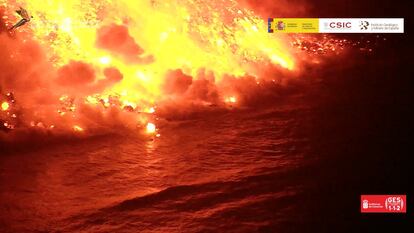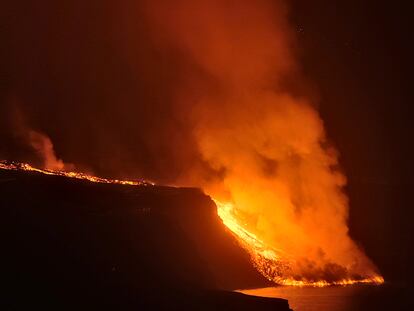Lava flowing to sea from La Palma volcano could head off in other directions
Experts analyze what the molten rock might do next if new fissures open up or if the current channel leading down to the cliffs fills up with volcanic material


It was an hour before midnight (local time) on Tuesday in La Palma, in Spain’s Canary Islands, when the lava flow from the volcano that erupted in the Cabeza de Vaca area of Cumbre Vieja national park reached the sea. It was expected to do this, although the changing rhythms of the eruption and the nature of the terrain of the Aridane valley raised doubts about whether it would arrive at all, and if so, where it would happen.
Since reaching the Atlantic Ocean, the lava from the volcano on La Palma has formed a 500-meter-wide delta in the sea. Strong winds have so far kept away the column of smoke rising from the shore, as well as any possible toxic gases due to the contact of lava with seawater.
On Wednesday, the island council of La Palma asked the residents of Tazacorte, a municipality of 4,601 residents located near the site where the lava is falling into the ocean, to remain in their homes. Meanwhile, at the volcano, the plume of ash and smoke is now rising 3,500 meters into the air. Fine ash even reached the nearby island of El Hierro on Wednesday evening, according to María José Blanco, the director of the National Geographic Institute (IGN). By Wednesday, the lava had reached 981 buildings on La Palma, 855 of which have been completely destroyed, and it had affected an area of 476 hectares.

Models had indicated that the inclination of the terrain would lead the tongue of lava towards the cliffs, and this is what happened. For this reason, the expectation is that the lava will continue flowing down, following the terrain. But just because it reached the water down this path, does not mean it has to continue to follow the same channel.
Volcanologist Ramón Casillas, a member of the scientific committee overseeing the volcano emergency plans, believes the idea that the lava will stably flow down this channel is “a bit of a myth.” “In reality, it doesn’t have to be this way. The lava flow could move to other places and leave this channel,” says Casillas, from La Laguna University. “It’s true that the main flow is located there, but there are other points where the lava flow continues to move.”
Indeed, the emergency committee indicated that while the lava has reached the sea, the eruption has not stabilized and needs to be observed. But Vicente Soler, from the Institute of Natural Products and Agrobiology at the Spanish National Research Council (IPNA-CSIC), believes that the change will help control the lava flow. “The fact that [the lava] directly connects with the sea cliffs is the best situation to ensure that the lava flow does not continue invading new terrain as it has done up until now,” he explains. According to Soler, who is also part of the scientific committee, any interruption in the activity at the center of the eruption, or the opening of a new vent, will likely lead to the appearance of a new tongue of lava, which will have to find a new path towards the sea.
Teresa Ubide, from the University of Queensland, believes that “the natural thing is for it to continue along this channel for now, because the topography is taking it there, but there could be changes.” Volcanologist Natividad Luengo Oroz, from the National Geographic Institute (IGN), who is following the eruption from Tenerife, also in the Canary Islands, says there are two possible scenarios. If the lava has chosen that path towards the sea, this could help stabilize this route. But, she warns, the volcano “is not necessarily going to create a channel in such a way that everything flows down it. If only! But that’s not the case.” The lava could cool, says Oroz, which would change the path of the lava flow. Lava from the same vent could even flow down the other side of the mountain.
Until now, says Luengo, the lava has done what was expected: it traveled to the sea down the forecast route, going around the mountain on its southern side. Although in theory it is expected to continue down this path, once it flows over these ravines, it could start to expand in other directions. “Nothing is 100% certain; this is not like water running along a riverbed. It is much denser, it is topographically filling up the lowest areas, but once it does this, it continues above it,” she explained. In these lava tongues, there are parts of the flow that are more than 12 to 15 meters in height.
In eight days, the eruption had released 50 million cubic meters of volcanic material. In comparison, the last eruption in La Palma, which took place in 1973 at Teneguía volcano, released 43 million cubic meters of magma in over three and a half weeks. And volcanic eruptions in La Palma tend to last between one and three months, meaning the volcano at Cumbre Vieja has time to release a lot more material, which could overflow the current channel.
“There is the not entirely correct idea that if fire meets water, then everything is over,” said the volcanologist Ramon Casillas. “But that is not the case: the lava continues advancing in other places. There are other tongues behind it.”
English version by Melissa Kitson.
Tu suscripción se está usando en otro dispositivo
¿Quieres añadir otro usuario a tu suscripción?
Si continúas leyendo en este dispositivo, no se podrá leer en el otro.
FlechaTu suscripción se está usando en otro dispositivo y solo puedes acceder a EL PAÍS desde un dispositivo a la vez.
Si quieres compartir tu cuenta, cambia tu suscripción a la modalidad Premium, así podrás añadir otro usuario. Cada uno accederá con su propia cuenta de email, lo que os permitirá personalizar vuestra experiencia en EL PAÍS.
¿Tienes una suscripción de empresa? Accede aquí para contratar más cuentas.
En el caso de no saber quién está usando tu cuenta, te recomendamos cambiar tu contraseña aquí.
Si decides continuar compartiendo tu cuenta, este mensaje se mostrará en tu dispositivo y en el de la otra persona que está usando tu cuenta de forma indefinida, afectando a tu experiencia de lectura. Puedes consultar aquí los términos y condiciones de la suscripción digital.
More information
Últimas noticias
Most viewed
- Reinhard Genzel, Nobel laureate in physics: ‘One-minute videos will never give you the truth’
- Oona Chaplin: ‘I told James Cameron that I was living in a treehouse and starting a permaculture project with a friend’
- Pablo Escobar’s hippos: A serious environmental problem, 40 years on
- Chevy Chase, the beloved comedian who was a monster off camera: ‘Not everyone hated him, just the people who’ve worked with him’
- Why we lost the habit of sleeping in two segments and how that changed our sense of time










































